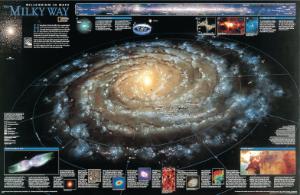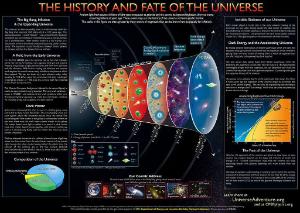Students Get Starstruck with these Facts About the Milky Way Galaxy
Middle School/High School
The word “Galaxy” originates from the Greek word gala, meaning “milk.” Studying the Milky Way gives the students in your science class a new way to decipher the breathtaking views they observe in the night sky to better understand how the Universe formed and continues to evolve. Galaxies like the Milky Way trace the structure of the visible Universe with their collections of billions of stars, gas, and dust. After your stellar lesson, students in your science class will be the few in a “billion” people who can answer questions such as
- What does the Milky Way look like?
- Where is the Milky Way located in our solar system?
- Why can’t we see the whole Milky Way from Earth?
- Why is our home galaxy called the Milky Way? Thanks, Hera, for spilling the milk instead of the beans, or we’d be living in the Beany Way!
- Is the Milky Way large or small compared with other galaxies or the Universe?
- What is the Milky Way made of?
So precisely what is that thin cloudy strip stretching across the night sky that we call the Milky Way?
Why’s our Galaxy so milky?
It’s hard to tell that the Milky Way is anything besides a faint, patchy glow with just your eyes. This is because there are large, dark clouds that obscure the dense collection of stars. So, when we see the Milky Way with our unaided eyes, we don’t see a uniform glow but a bright glow interrupted by dark patches. That’s how it became compared to milk. However, with even the smallest telescope or binoculars, we can resolve this glow into individual stars.
Astronomers have calculated that our barred spiral Galaxy has over 200 billion stars and a diameter of 100,000 light years. Got milk? Our Galaxy does!
Structure and composition of the Milky Way Galaxy
The Milky Way’s structure is typical of a large spiral system. This structure contains four major structural subdivisions: the nucleus, a central bulge, disk, spiral arms, and a massive halo. Some of these components blend into each other.
The nucleus
The galactic nucleus makes up a tiny component of the Galaxy; it extends roughly 400 light-years from the Milky Way’s center. The nucleus is an extreme region containing a supermassive black hole (Sagittarius A*) and extremely high stellar densities (around 10 million stars). Don’t worry; the black hole won’t swallow us up. Our solar system is a comfortable 26,000 light years away from the event horizon, the boundary that marks the black hole’s point of no return. From that distance, a black hole is just like any other object with the same mass. It doesn’t have any magical power to suck things in. Its gravity is just like the gravity of anything else. Phew!
Central bulge
The bulge is a round, dense swarm of stars in the Milky Way center approximately 10,000 light years across. The bulge is a round structure made primarily of old stars, gas, and dust. The outer parts of the bulge are hard to distinguish from the halo. Hopefully, this dispels any rumors that the center of the Milky Way Galaxy is filled with nougat and caramel.
Disk
The disk is a thin distribution of stars and gas orbiting the nucleus of the Galaxy. The disk is shaped like a pancake. The Milky Way’s disk is 100,000 light years across and 1,000 light years thick. The familiar spiral arms of the Milky Way are located in the disk. It contains mostly young stars, gas, and dust, which are concentrated in spiral arms. The disk is also where most of the present-day star formation occurs--our own adorable star nursery.
Spiral Arms
The spiral arms are curved extensions that begin at the bulge of a spiral galaxy, giving it a “pinwheel” appearance. The spiral arms contain a lot of gas, dust, and young blue stars. The Milky Way is constantly rotating, so the arms are moving through space. The Sun and the solar system go along for the ride. The solar system travels at an average speed of 515,000 mph (828,000 km/h). That’s fast! At that speed, it’ll only take a mere 230 million years for the solar system to travel all the way around the Milky Way.
Halo
The halo primarily contains individual old stars and clusters of old stars (“globular clusters”). Hmmm, does that make it the retirement village of the Galaxy? The halo also has “dark matter,” which is material that we can’t see but can measure its gravitational force. The Milky Way’s halo may be over 130,000 light years across.
With all its grandeur, it’s incredible to think our Sun is just one of about 200 billion stars in the Milky Way Galaxy. As astronomer Carl Sagan would say, one of “billions and billions!”
Get your lesson plans started quickly because our Milky Way Galaxy is scheduled to bump into Andromeda, our closest galactic neighbor. Okay, okay, it won’t happen for about five billion years, but why not plan ahead? In the meantime, it will excite the future astronomers in your class to discover all the fascinating facts about our home galaxy.
Recommended products
[StartProductBlock]

Show Me Science: Galaxy - The Milky Way
Students will see the enormous span of the Universe, some of our neighboring stars and an excellent description of the life of a star. Available as a digital download.
[EndProductBlock]
[StartProductBlock]
Show Me Science: Astronomy & Space - Far Out - Measuring the Universe
How far is a star or a galaxy? Scaling and measuring the cosmos is a complex problem. Scientists are integrating mathematical applications and scientific technology to create standards.
[EndProductBlock]
[StartProductBlock]

Celestron PowerSeeker 60 Refractor Telescope
An ideal combination of quality, value, features, and power, this telescope is well-equipped for both celestial and terrestrial viewing. Optical performance is provided from a 3X Barlow lens, tripling the magnifying power of each eyepiece.
[EndProductBlock]
[StartProductBlock]

The Milky Way Chart
Vivid color imagery showing the detail of the Milky Way Galaxy. The easy to read chart information will expand students’ knowledge of the Milky Way, while additional photos and callouts describe the different styles of galaxies shown. Size: 20" x 30".
[EndProductBlock]
[StartProductBlock]

CPEP History and Fate of the Universe Charts
Illustrates and summarizes what is now known about the history and fate of the universe. The chart is crammed with information covering a broad range of cosmological topics.
[EndProductBlock]
